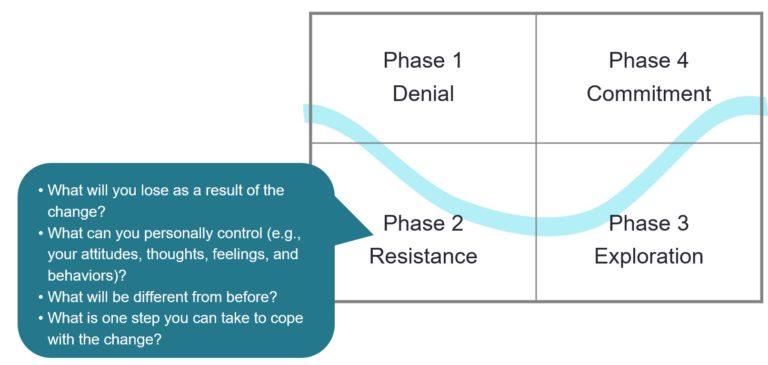
Leading in times of crisis: How healthy optimism works
Crises are as much a part of business as stormy weather at sea. But what if the storm lasts longer? 3 impulses for strong leadership in a crisis.

Resistance makes any change stressful. This time, our Inside Transformation series looks at a particularly thorny issue: What can you do when executives boycott your project?
If you manage transformations often, sooner or later you’ll have this particular problem: Executives don’t show up for important meetings, respond late or not at all to requests, or talk badly about your project behind your back.
The comforting thing is that this happens in the best companies. These behaviors are a form of resistance and a normal response. Even if it sounds strange at first: Resistance is in itself a good sign – that something is really changing in the company.
However, resistance should not be dismissed. The first question is:
Essential change homework includes:
If you can check off these items, you can look for the problem elsewhere-specifically, with the person who is resisting. Then it is most likely the fault of the individual leader. Or the context in which she is operating.
However, this does not mean that the colleague is “at fault” and should be confronted. It is more likely to be successful if you try to have a constructive conversation, take your time, and listen until you understand what the real problem is.
Often there are very obvious issues:
Fear of losing control and authority
For example: A company wants to outsource IT services. The long-time head of IT assumes that parts of his department will be affected. As an opponent of outsourcing, he fears that processes will not run as smoothly, that the most talented people will go elsewhere, and that his leadership position will become irrelevant.
Stress and lack of time
Example: The director of human resources is asked to implement a new human resources information system with her team. At the same time as the system is being implemented, two other projects need to be managed. The manager feels overworked, but has not been able to make her voice heard.
Satisfaction with the status quo
Example: In customer service, a new digital communication tool is expected to reduce face-to-face meetings and save time. The department manager doubts that this calculation will work out: In her eyes, the tool weakens the team dynamic at the expense of service quality.
No concrete answer to the question “What’s in it for me?
Example: A sales manager does not see the value of a new reporting tool for his own team. There is also a fear: performance becomes transparent and comparable – could this actually hurt his own team?
Mistrust due to company history
Example: A major change project failed a few years ago. As a result, the production manager considers the current project to be a waste of time and money.
If you know the reasons, you can take countermeasures. However, as a transformation manager, you can’t do much on your own and need the support of top management. It’s best to sit down with the project sponsor and consider what actions might change the uncooperative executive’s mind:
Provide reassurance
Openly expressed concern for the team is often masked by concern for their own future. As the transformation leader, you can approach the executive and explain as concretely as possible what his or her future role will look like – and be sensitive to what the other person wants.
Sometimes there is a lack of belief in improvement because previous transformations have failed. Then you can explain the reasons for those failures. Point out how the company learned from those mistakes and how you will avoid them in the current transformation.
Break down barriers
If the leader is stressed, offer supportive resources. If he or she is overwhelmed, provide training or coaching.
For example, the sponsor might work with the executive to determine where he or she is psychologically with the change: Where does he or she stand on the curve of change (see figure below)? In a coaching process, the sponsor can rely on a list of questions appropriate to the change stage. During the resistance phase, these questions would be such as: What can the leader personally control? (e.g., attitudes, thoughts, feelings, behaviors)? What steps can he take to cope with the change?, etc.

Show individual benefits
It may be necessary to elaborate on your change story and explain in more detail how individual areas will benefit.
Again, this is where the senior executive should be involved:
Leaders ultimately respond to change the same way most other people do: The vast majority love the status quo. Resistance to change is human – and therefore easy to predict.
With careful stakeholder analysis, we can be proactive. We can anticipate who the “difficult” stakeholders are, approach them, and in the best cases, even turn them into allies.
Would you like to learn more? Here is our step-by-step approach to successful transformation management.

Crises are as much a part of business as stormy weather at sea. But what if the storm lasts longer? 3 impulses for strong leadership in a crisis.

He conveyed confidence in a desperate situation: British polar explorer Ernest Shackleton and his team survived a two-year battle for survival in the Southern Ocean. What can leaders learn from him in times of crisis?

Getting an IT project across hundreds of organizational units to the finish line? Our colleague Mathis takes a sporty approach. In our interview, he tells us what excites him about project management as a consultant and why he goes to the boxing ring to compensate.
2021 Grosse-Hornke Private Consult